Kalliope CTI Mobile IOS
Changelog iOS
KalliopeCTI Mobile App Version 4.9.3
Bugfix:
Fixed bug where it was not possible to transfer/pause a received call with the device in standby.
Fixed bug that caused the echo cancel software to be activated even in non-handsfree mode.
Fixed graphics on audio boost in call
KalliopeCTI Mobile App Version 4.9.2
Features:
Added panel for configuring echo cancellation algorithm parameters.
Starting from version 4.9.0 it is possible to enable/disable the hardware echo cancellation when the hands-free mode is active. This feature can be enabled in the Settings panel of the application.
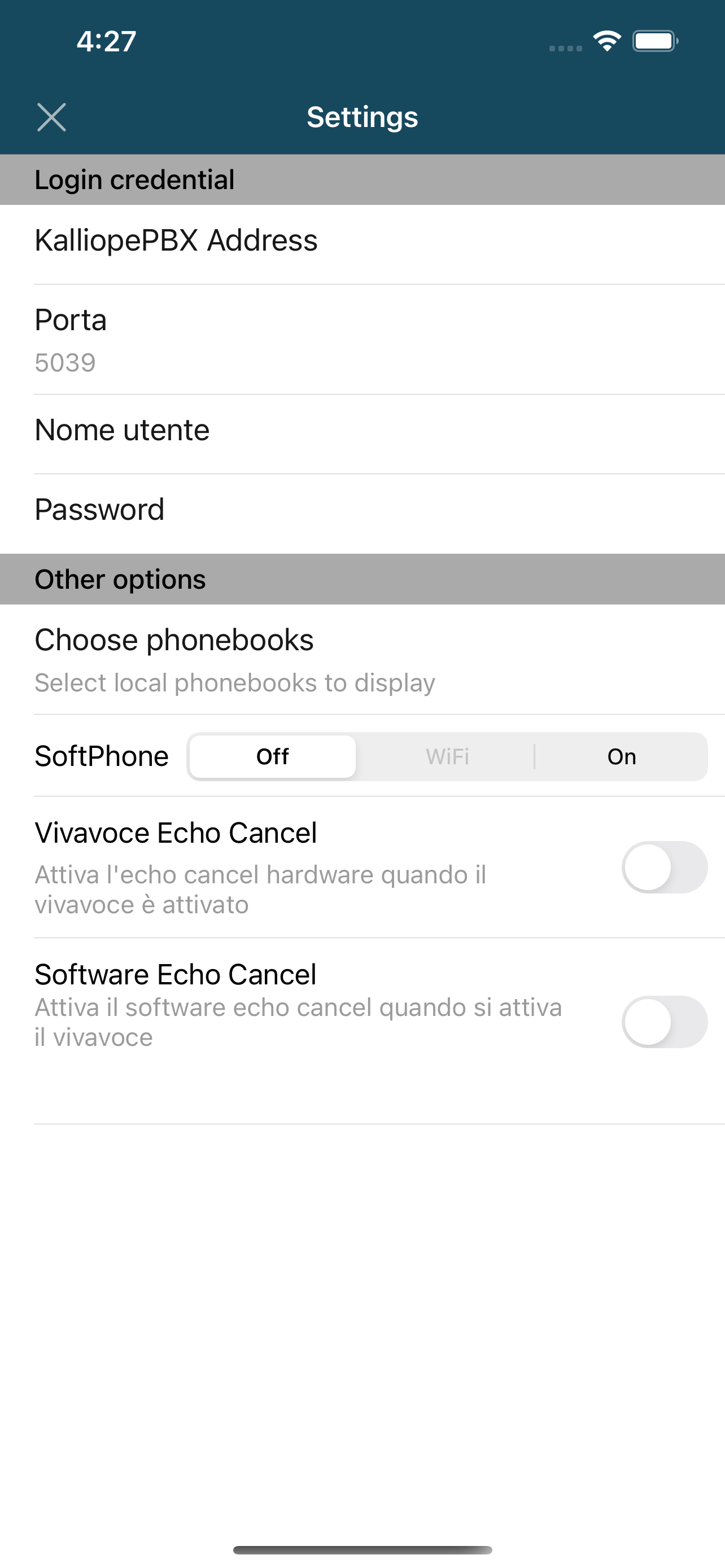
Starting from version 4.9.1 it is also possible to enable, in addition to the hardware echo cancel, a software echo cancel algorithm implemented in the app. Also this feature is enabled in the Settings panel of the application and the algorithm parameters are configurable by clicking on the gear under the label of the item to be enabled.
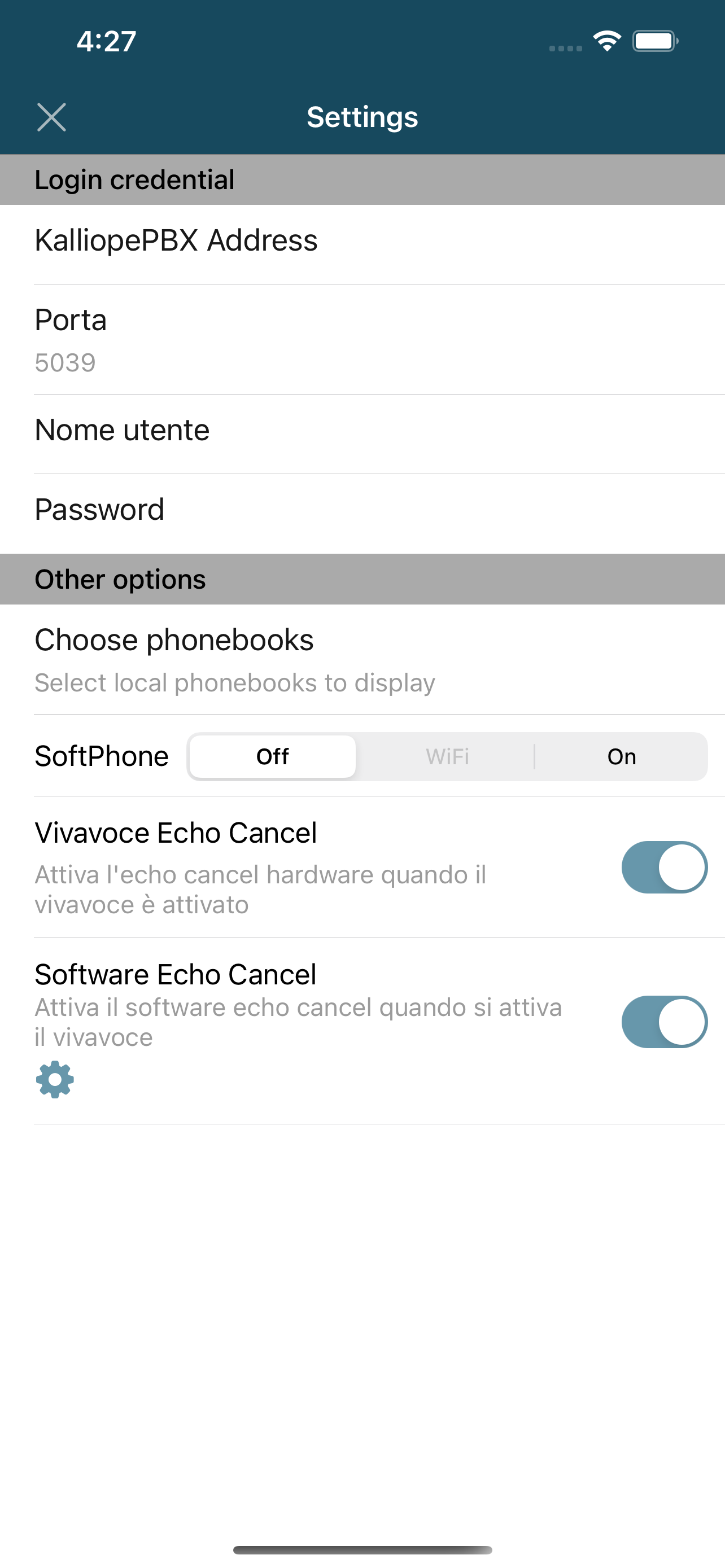
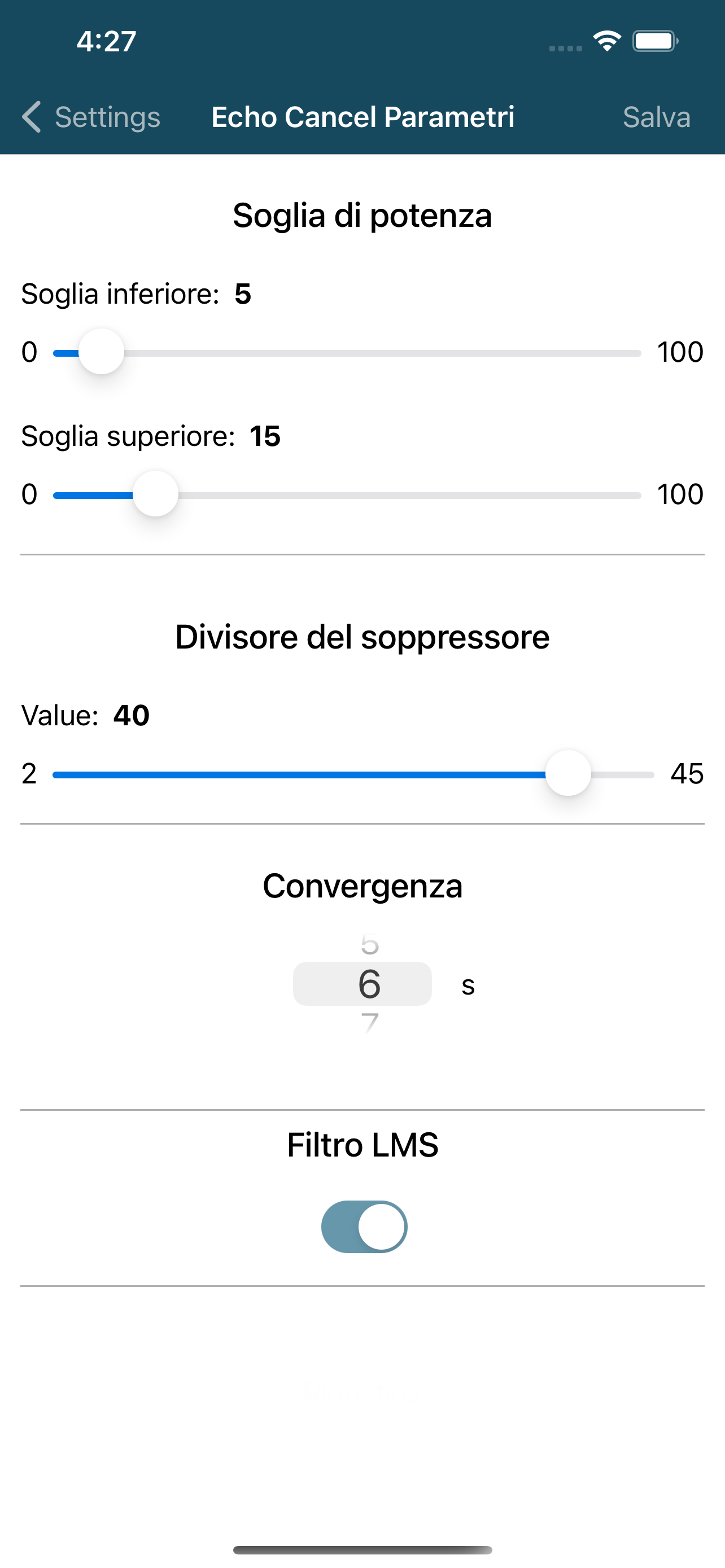
The software echo cancellation feature requires that hardware echo cancellation is also enabled.
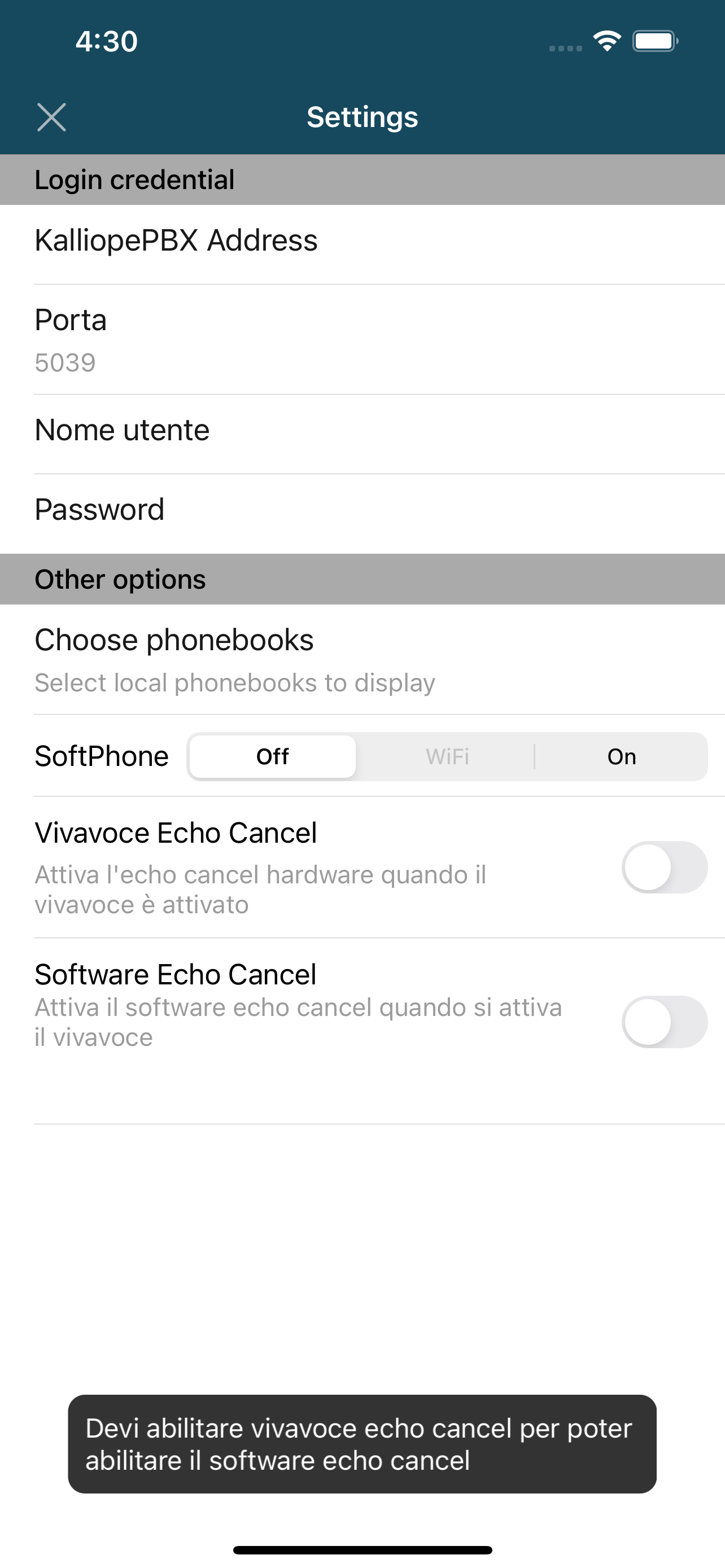
Bugfix:
Fixed call widget display issue on IOS 15.1.
Minor graphic fixes on IOS 15.1
KalliopeCTI Mobile App Version 4.9.1
Features:
Added echo cancellation functionality on hands-free speaker.
KalliopeCTI Mobile App Version 4.9.0
Features:
Transfer mode has been replaced from “blind” to “with offer” when connected to exchanges with firmware greater than 4.13.0. Call transfer can only start when the call has been established and is in progress. For more details on this new feature Click here
Speakerphone can now be activated when starting a call and not only when it is in progress
Bugfix:
Fixed an issue where the app kept ringing if a group call was answered elsewhere.
KalliopeCTI Mobile App Version 4.8.2
Features:
Added an action to refresh the cdr list manually. Swipe-to-refresh on CDR list that will download the updated call list from PBX
Bugfix:
The app notifies the PBX of the rejected call when the app is forcibly closed.
In cti mode, the speed dial icon calls click.to.call to the deskphone instead of the cell phone
Speaker has the same low volume when activated from the default iOS panel, instead of the kcti screen
When a second VoIP call ends, the current one is terminated
Try changing the numbering index of iCloud accounts to resolve duplicate accounts
KalliopeCTI Mobile App Version 4.8.1
Features:
Improved PLC algorithm that increases call quality in case of limited packet loss events.
Bugfix:
Increased the speakerphone volume.
Fixed an issue where the Bluetooth headset (if connected) would not automatically activate during a call
KalliopeCTI App Mobile Version 4.8.0
Features:
Introduced Siri / Carplay support, now you can use the app by saying:
Hey Siri call using Kalliope / KalliopeCittii / KalliopeSittiai
Hey Siri call the number using Kalliope / KalliopeCittii / KalliopeSittiai
Hey Siri use Kalliope / KalliopeCittii / KalliopeSittiai to call
Hey Siri use Kalliope / KalliopeCittii / KalliopeSittiai to call the number
Added a popup panel to boost the audio signal of microphone and speaker
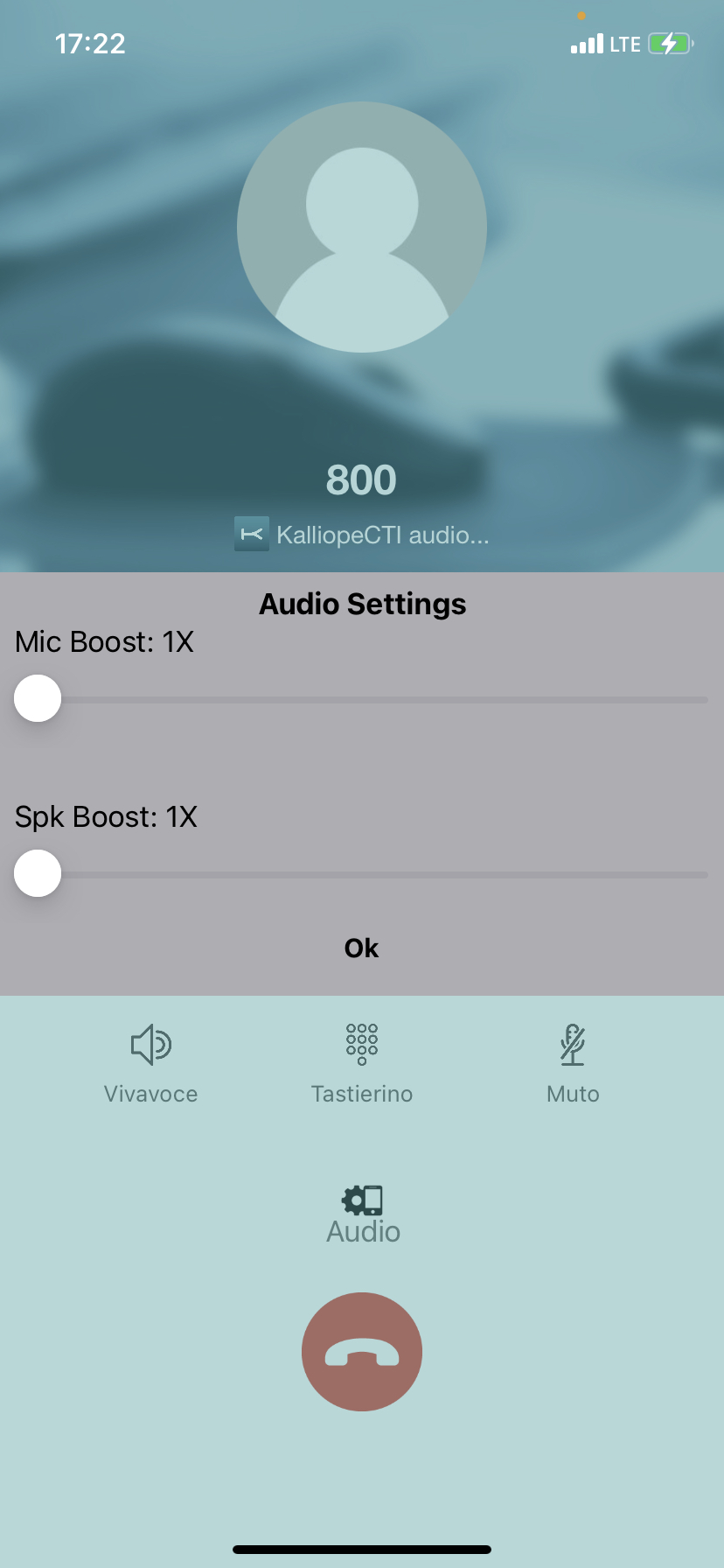
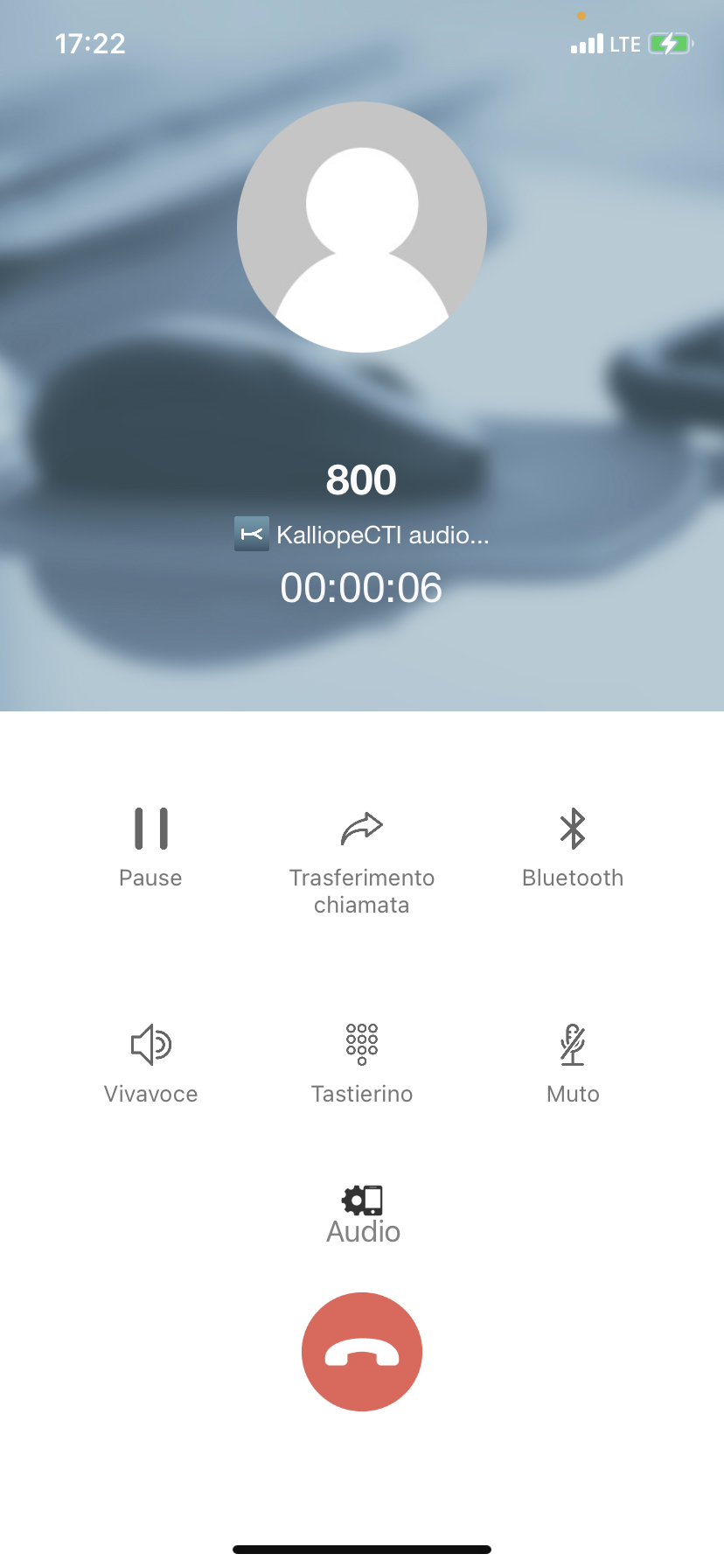
Bugfix:
Fixed an issue where it was impossible to use central addresses with very long domain names.
Fixed an issue where in the cdr display the calls were always identified as incoming.
Fixed an issue where the lookup of the address book did not recognize the number if it was presented without country-code and was stored with CC instead (and vice versa).
For iOS operating systems
It is no longer possible to select the mode to run the app while not connected to Kalliope (due to a restriction by apple on sending notifications). For the same reason the option to use softphone mode only if the phone is connected to wifi has been disabled, KalliopePBX needs to know how to send notifications, but can’t know if the phone is in wifi coverage or not.
We also added the possibility (starting from KalliopePbx firmware 4.7.12 or higher) to add, modify, delete a contact from the KalliopePBX personal address book directly from the app: pressing the label “+ Add Contact” opens a new screen. Once the fields are filled, the added/modified contact will appear in the contact list with a loading symbol. This symbol will automatically disappear as soon as Kalliope notifies the app that the changes have been accepted and registered on the pbx.
iOS Specifications:
Requires iOS 10.3 or later. Compatible with iPhone, iPad, and iPod touch.” -> app does not support iPad.
Devices using iOS 13 and higher must connect to kalliope 4.10.x or higher for proper operation.
Languages: Italian, English
Product available only if associated with a KalliopePBX® V4 VoIP PBX
Minimum KalliopePBX firmware version: 4.10.x
Suggested KalliopePBX firmware version: 4.11.x
Integration of the native iOS CallKit libraries to ensure that the softphone can always be reached even when the terminal is on standby.
A KalliopeCTI Pro license is required for the use of GSM™ mode only. A KalliopeCTI Phone license is required to use both modes, GSM™ and Softphone.
Note
Softphone mode is in beta version and currently has the following limitations that will not be present in the final, upcoming version:
It is not possible to handle more than one SIP call at a time
Bluetooth support needs to be refined
SIP/TLS has not been enabled yet
Resuming a paused call may sometimes fail
Organization of the GUI
When you first start the KalliopeCTI app, you need to go and set the configuration parameters to allow the app to connect to KalliopePBX.
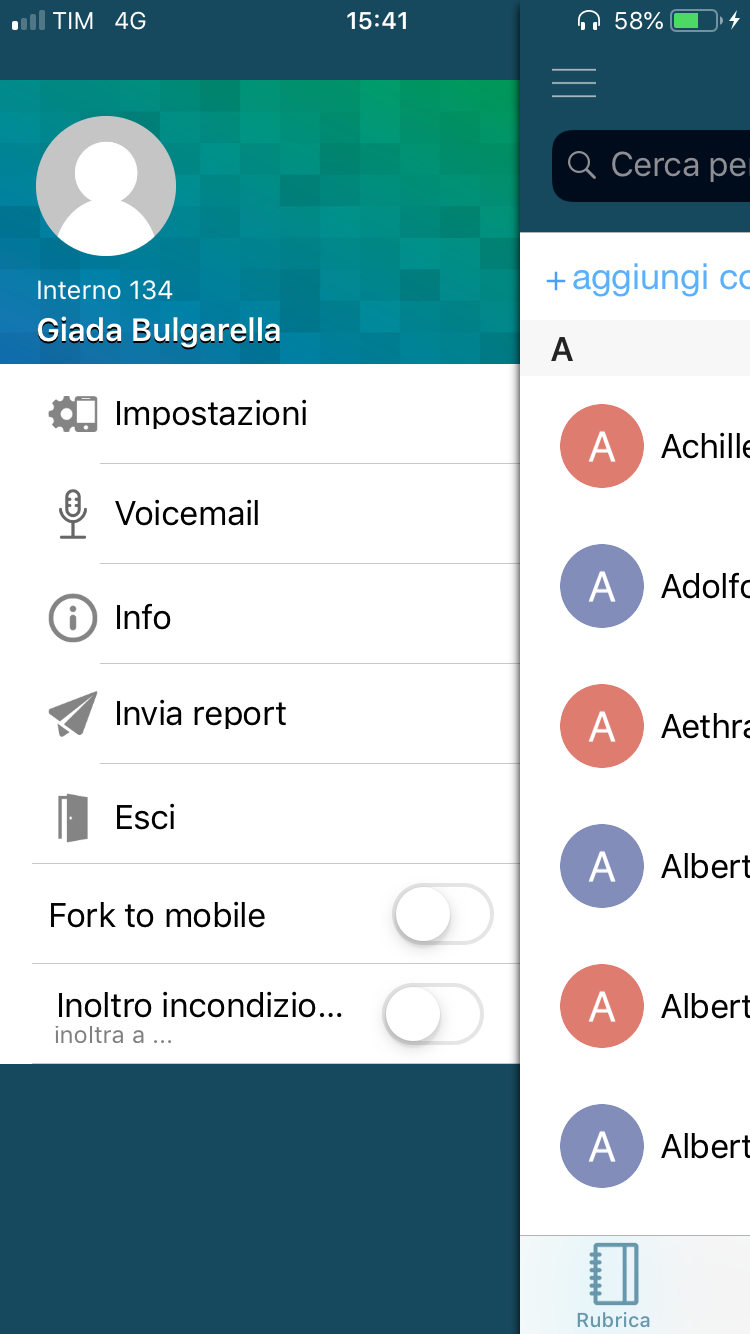
By clicking on the menu button symbol at the top left you can access the system menu containing the following items:
Settings: application configuration panel
Softphone settings: allows to set the mode of the application (iOS only)
Softphone disabled: the app forcibly works in call-back mode. In this case the KalliopeCTI Pro license is sufficient.
Softphone enabled: the app is forced to work in softphone mode. In this case, the KalliopeCTI Phone license is sufficient.
Softphone enabled on WiFi only: the app will automatically switch to softphone mode if the connection is established with a WiFi network. Switching to softphone mode will only be possible if the KalliopePBX user is associated with a KalliopeCTI Phone license.
Voicemail: direct access to voicemail messages
Info: provides information about the installed version
Send report: allows you to send a report to the developers in case of abnormal behavior of the app
Exit: closes the app and you will not receive any more notifications until the next time you open again the app.
The main screen of the application is shown here and consists of a top bar.
The top level bar shows the name of the tab you are currently viewing (in this case Address Book). Allows you to search within each tab and shows the connection status of the app via the K symbol in the top right corner. The top level bar (header) for iOS is shown below.
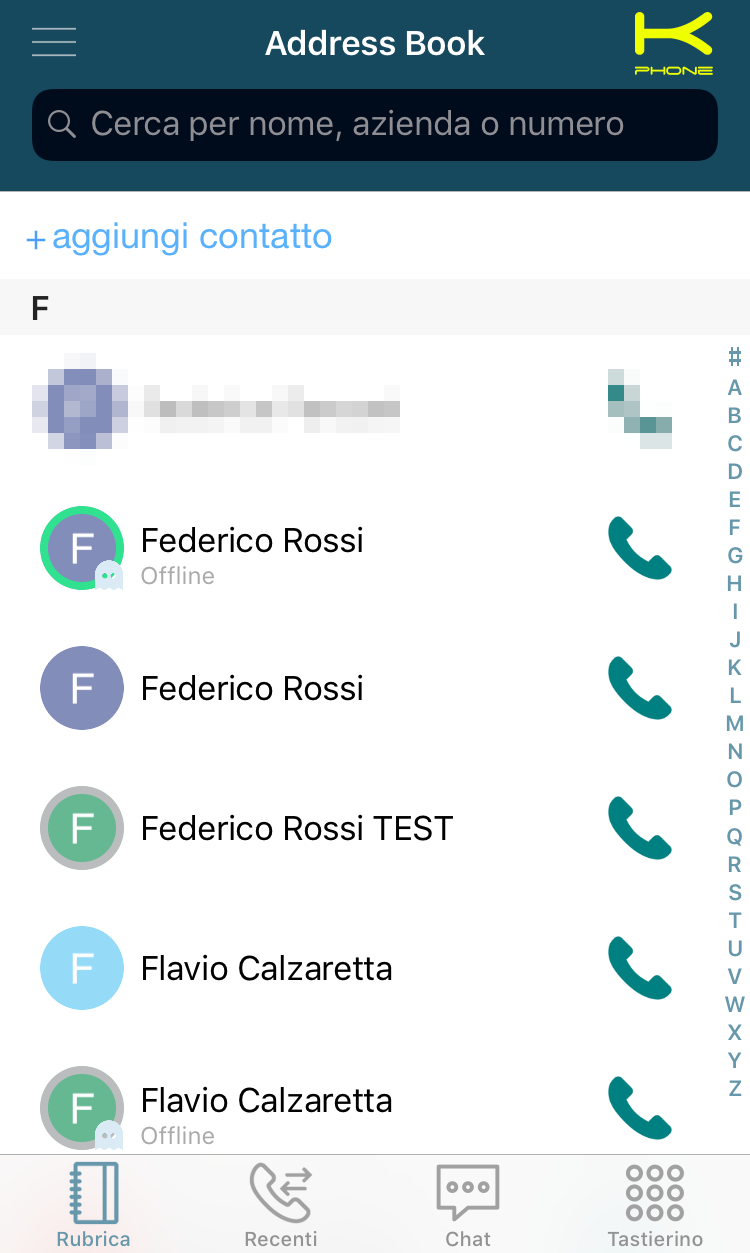

The connection status is indicated by the color of the K symbol in the upper right corner:
gray = not connected
green (with the word “cti”) = connected in call-back mode.
yellow (with the word “phone”) = connected in softphone mode.
The footer includes the navigation bar between the main sections of the app.

In both cases, the navigation bar allows you to explore the main tabs of the app:
Keypad: the numeric keypad for dialing numbers
Phonebook: extensions, KalliopePBX phonebook, favorite contacts, and, if enabled, personal contacts of the device in use
Call History: list of dialed, received and missed calls grouped by contacts
Chat: conversations started with other KalliopeCTI users, both mobile and desktop.
Settings Panel
First of all you need to configure some simple parameters from the Settings panel reachable through the system menu:
Login credentials
Server (Host name or IP address): IP address of the KalliopePBX central unit
Port: 5039
User name GUI/CTI user name
Password of the GUI/CTI user
Calls
Ringtone: useful to differentiate the incoming calls to the mobile number from the incoming calls to the extension
Display device contacts: allows to choose the address books from which to display contacts.

Contacts
The Contacts screen, second icon from the left, shows all KalliopePBX contacts, both extensions and address books, placing favorite contacts at the top.
The extensions are recognizable by the presence of the BLF field (colored circle) and the chat presence (icon and status).

Clicking on the various contacts will take you to the detail screen containing the following items:
Name and Surname of the contact
Origin of the contact (Kalliope or phonebook)
List of phone numbers associated with the contact with icons for the different calling modes available
Please refer to the Call management section of this manual for more information about the different call modes.
By pressing on the title of the screen (default Contacts) you can filter the address book as follows:
Contacts: shows all contacts
Extensions: shows only the extensions of Kalliope
Address Book: shows only the contacts of Kalliope address book and of the device
For extensions only, presence and BLF status are also displayed.
The BLF status can be:
Green: available
Yellow: ringing
Red: busy
Gray: not registered
From this tab you can also add the contact to you favorites by tapping the Kcti favourite button.jpg icon in the top right. Favorite contacts will be displayed at the top of the Contacts list.
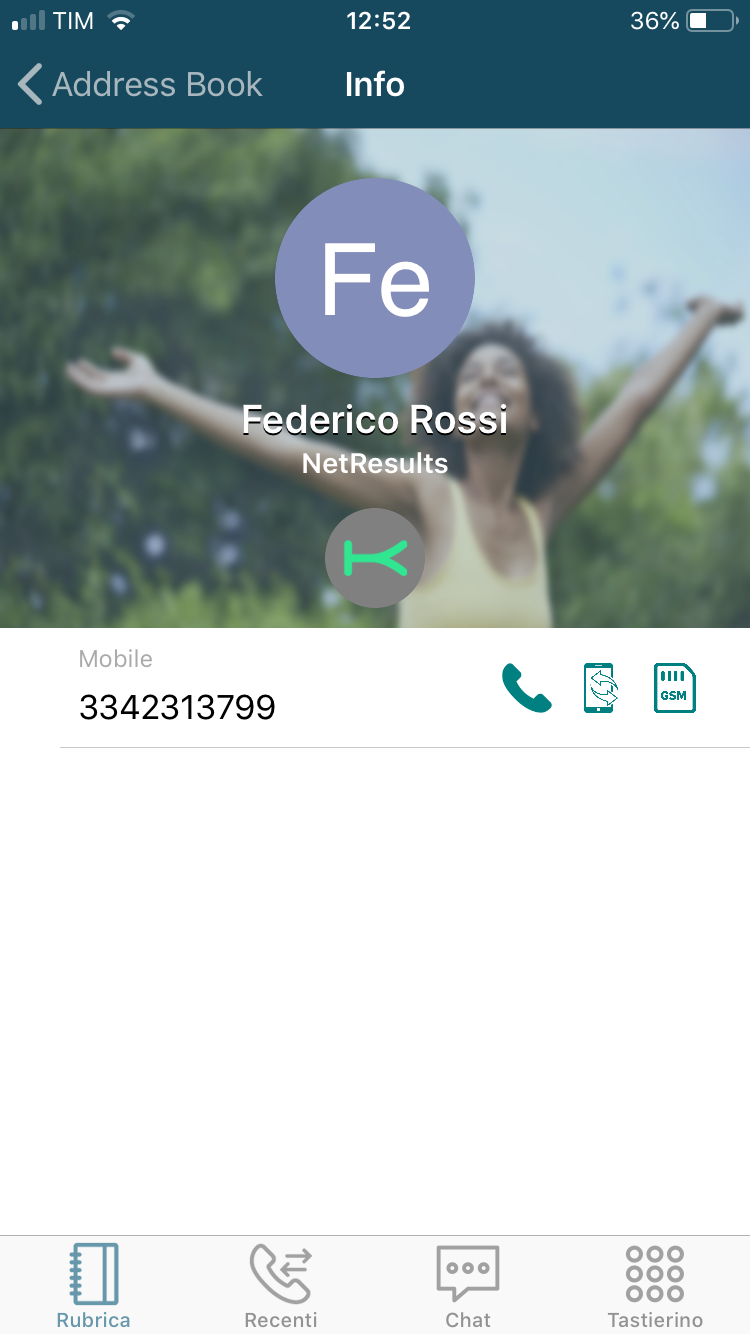
Add contacts
By clicking on the button “+ add contact” placed immediately below the top level bar (header) it is possible to insert a new contact by filling in the form shown in the figure. The created contact will be inserted in the user’s personal Kalliope address book.
Call history
This tab displays the call history of the logged-in user.
The calls are divided in:
Made calls
Answered calls
Missed calls
Calls are grouped based on the called or calling contact/number, and the total number of calls is shown in parentheses.
Tapping each row will display all calls to or from the selected contact, as shown in the figure.
A notification will be displayed if there are any voicemail messages; tapping the notification will open the voicemail box, where you can listen to and manage messages.
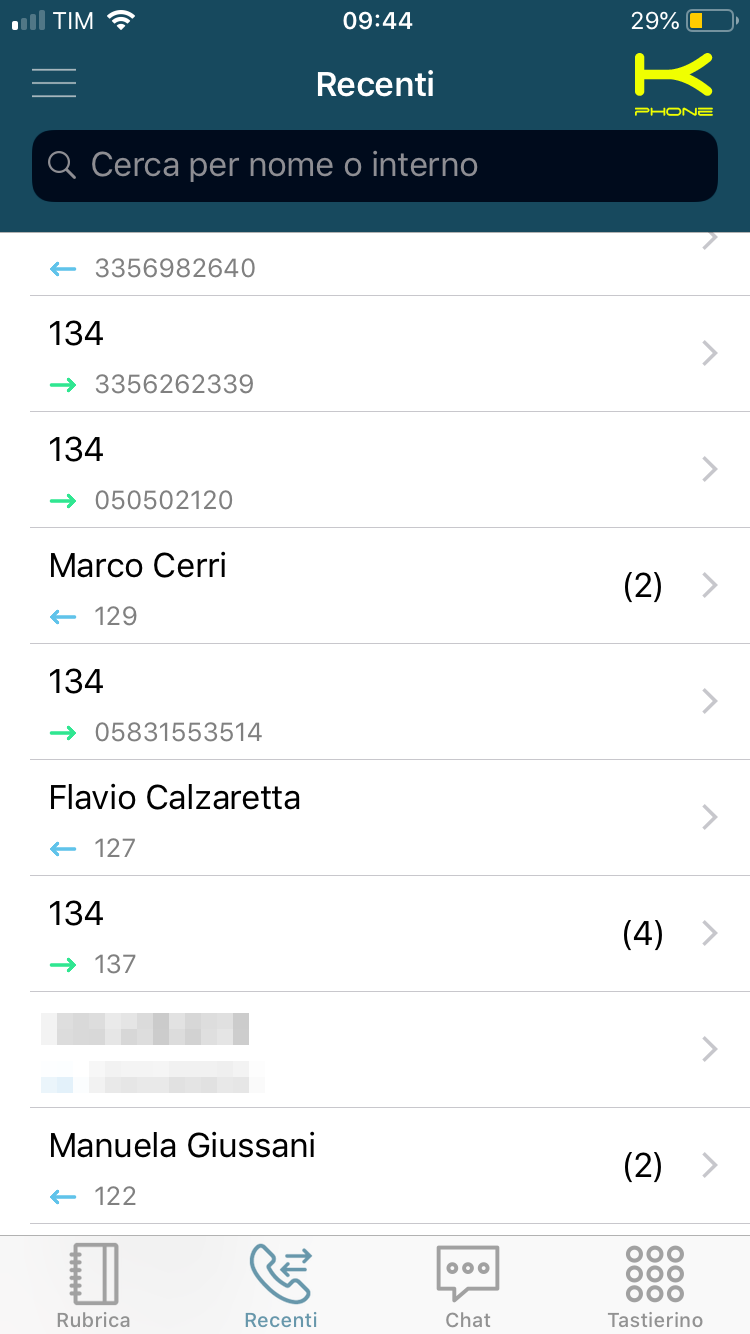
The call detail by contact includes all calls to and from the contact in chronological order.
For each call, the following information is displayed:
Type (made, answered, missed)
Date
Time
Duration
You can also call the contact with the available modes based on type of contact (extension or external number).
Voicemail
You can access your voicemail from the system menu to quickly and easily access all messages saved on the PBX or a remote storage. For each voicemail message sender, date, time, and length are displayed.
The messages are not automatically saved to the device but can be downloaded by tapping the icon next to each message.
Once downloaded, you can play the message directly on the device.
The app also allows you to manage the status (read, unread, urgent) and the deletion of messages. Messages can be deleted from local storage, remote storage or both directly from the app by clicking on the trash symbol.
To access the message management menu, simply tap and hold a message for a few seconds and the management options will appear, as shown in figure.
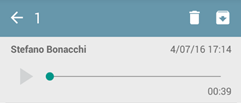
Note
Messages forwarded via email and automatically deleted will not be shown on this page.
Instant Messaging
KalliopeCTI offers a handy chat and presence management service that lets you easily talk to to other Kalliope users. To open a new chat, you can simply tap on the desired contact, then on the chat icon.

Within the chat, KalliopeCTI displays the status of sent messages with the following icons:
Not sent
Sent
Delievered
Note
Chat messages that could not be sent because CTI is offline, will be sent upon the next login.
The presence status can be changed directly in the Chat tab.
In addition to the status, the user can also enter a custom message that will be displayed along with the presence.
The possible statuses are:
Available
Away
Busy
Not available
Offline
Call management
Inbound calls in CTI mode
For inbound calls to the KalliopePBX extension, will send a notification to the mobile app and the screen shown in the picture to the right will be displayed.
As they use the official notification engine of their operating systems, these notifications will be sent even when the app is closed.
This screen allows you to perform three actions:
Slide down: the call is ignored, the notification on the mobile is muted and the user’s extension keeps ringing
Transfer to mobile: This button is only present if a mobile number has been entered in the user’s settings on Kalliope. The user’s extension stops ringing and at the same time Kalliope establishes a call to the mobile number associated with the extension by the system administrator in the Extensions configuration panel. The call will then arrive on the mobile’s SIM showing the geographic number of the line associated with KalliopePBX as the sender. By answering this call you are directly connected to the caller. This call forwarding is completely transparent to the caller, who will hear the ringing tone during the whole call establishment period.
Reject: the call is dropped by the PBX and, consequently, the extension stops ringing.
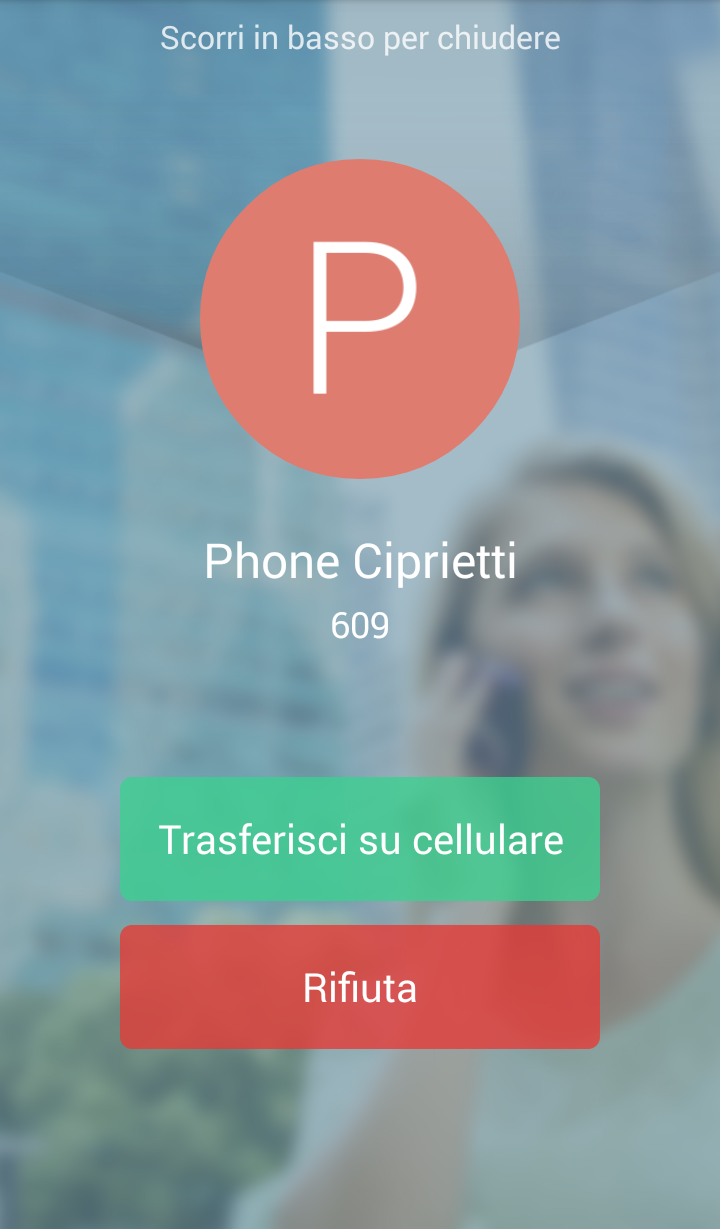
Incoming calls in Softphone mode
In case of incoming calls to the extension KalliopePBX will send a push notification that will trigger on the mobile the incoming call screen like the one shown in the figure. These notifications arrive even when the app is turned off, ensuring that the user can be reached even when the smartphone is in standby.
This screen lets you select one of three options:
Refuse: the PBX will refuse the call and the extension will stop ringing.
Accept: the KalliopeCTI app will wake up in softphone mode, the “Active call” screen will be displayed, and the SIP call will be established directly via the app. The smartphone will effectively become an extension of KalliopePBX.
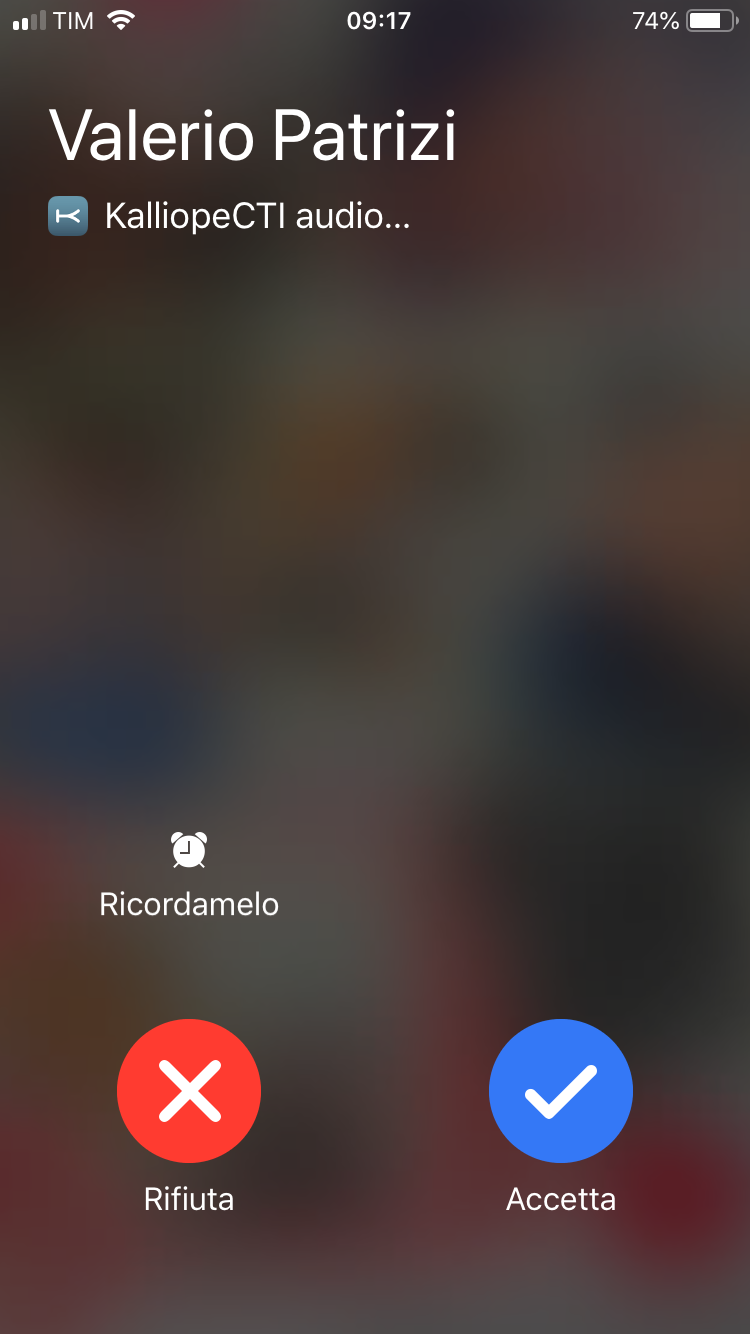
The Call in progress screen shows the name and number of the caller at the top, and the buttons for the functions available on the current call at the bottom:
Pause: the call is put on hold. The button can also be used to resume the call from the pause.
Call transfer: blind transfer of the call to another number (internal or external).
Bluetooth: activate/deactivate bluetooth headset.
Speakerphone: enable/disable the handsfree of the smartphone.
Keypad: activates the keypad screen (e.g. to navigate a IVR menu)
Mute: enable/disable smartphone’s microphone
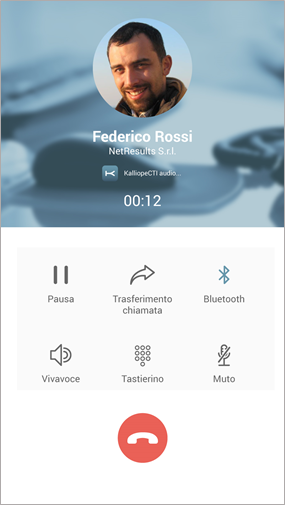
Call transfer (with offer)
Starting with version 4.9.0, the transfer mode has been replaced from “blind” to “with offer” when connected to exchanges with firmware higher than 4.13.0. Call transfer can only start when the call has been established and is in progress. After clicking on the “call transfer” button, the user will be presented with a popup from which he can choose how to insert the contact to which the call should be transferred
Address book
Keypad
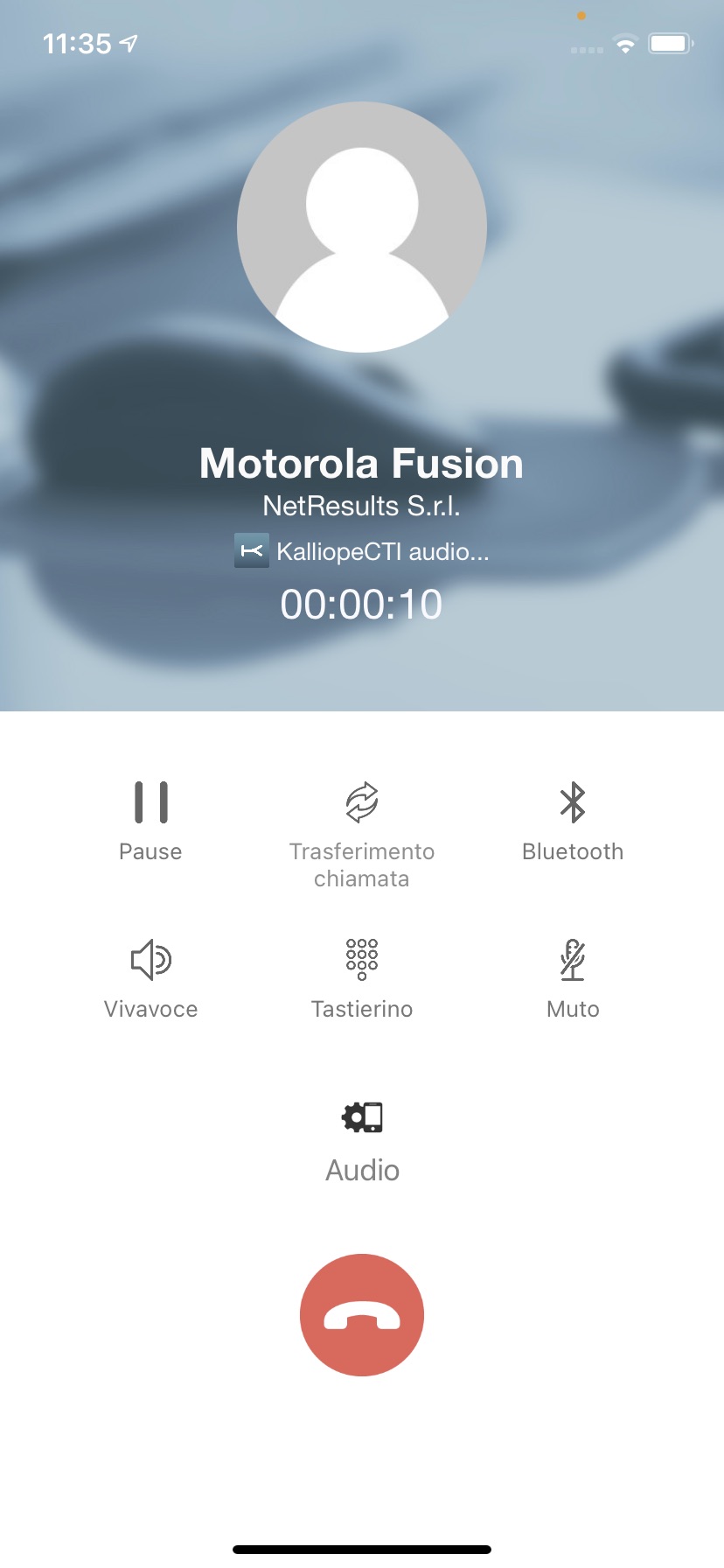
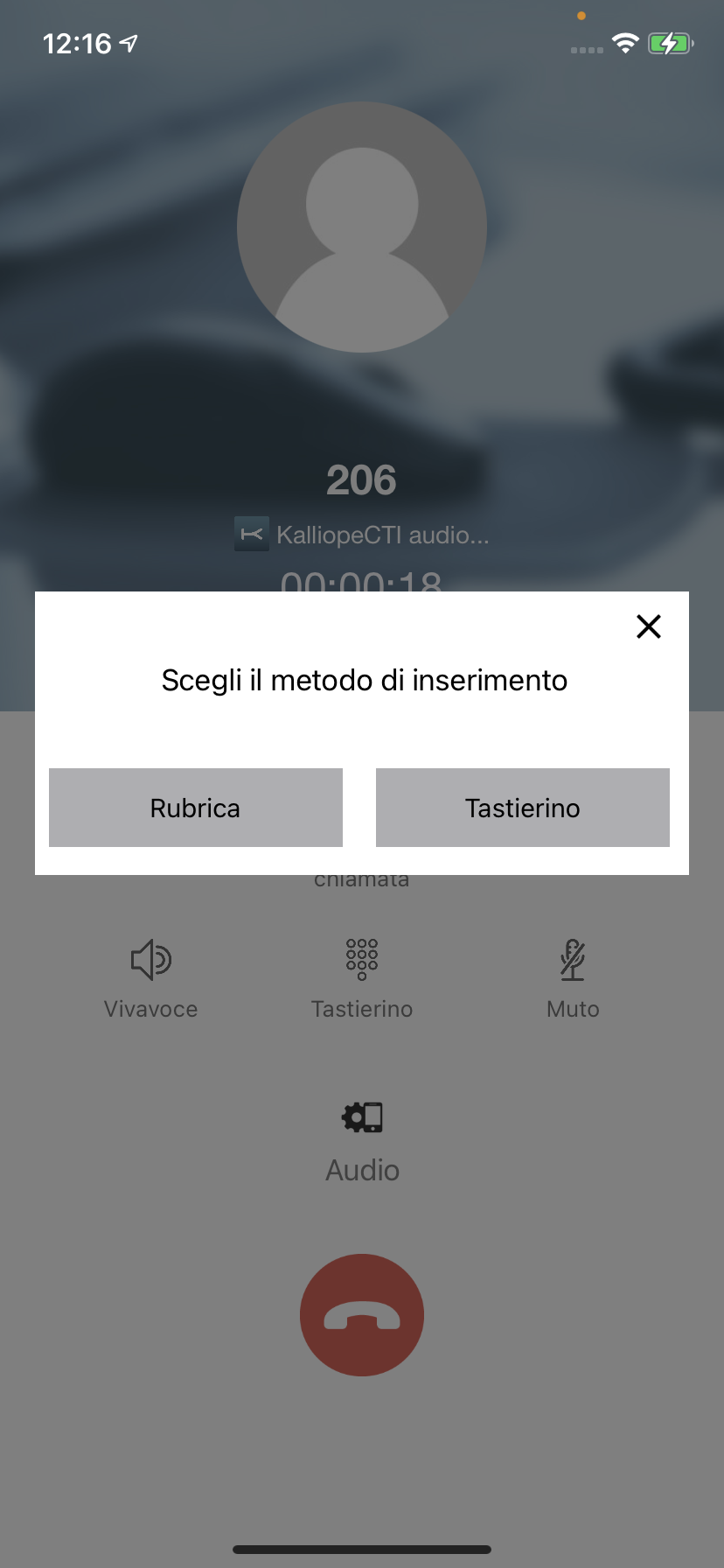
Address Book
In this case the contact can be selected from the Kalliope address book. This screen is equivalent to that of the address book already present in the app.
The contact search can also be carried out using the search bar at the top. The main difference between this list and the address book search is the presence of the contact number to the right of the contact (if it has only one number) or three dots (if there are multiple numbers associated with the contact).
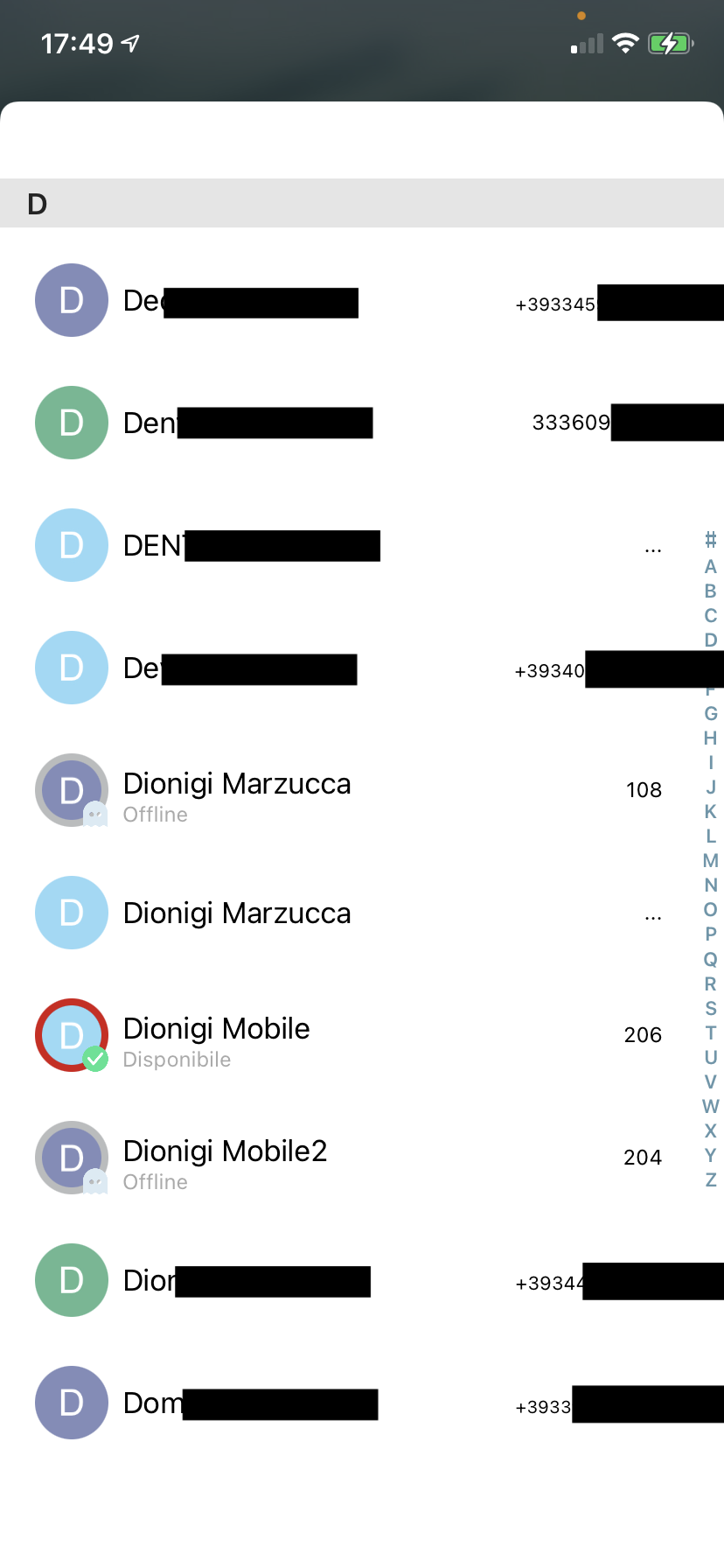
If you press on a contact that has multiple numbers, a screen opens where you can choose from the available ones. In this screen you have information about the contact to whom you want to transfer the call (name and number). At this stage you can choose whether to transfer the call (green button with the word Transfer) or cancel the transfer (red button with the word Cancel).
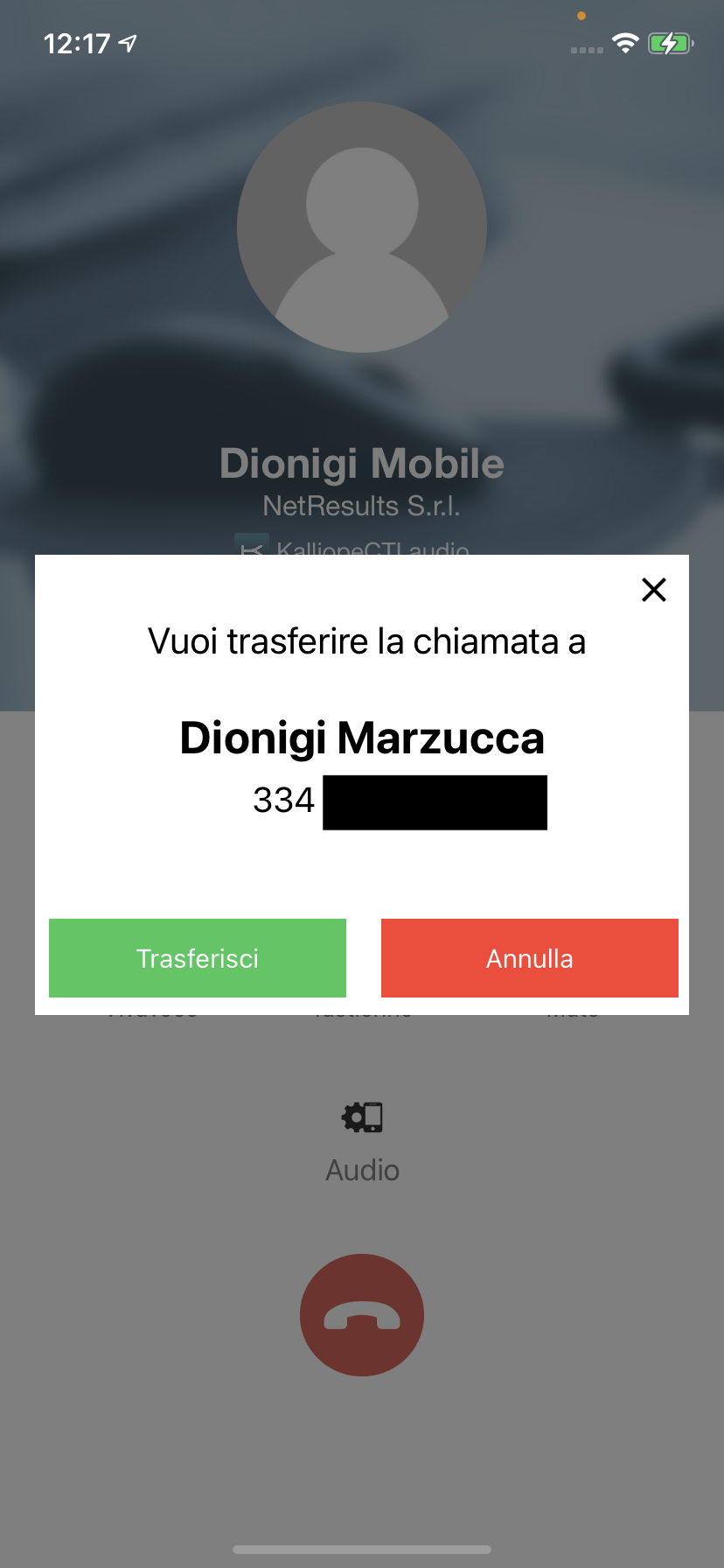
In this in-progress transfer screen you have the option to complete the transfer ( green button ) or cancel the transfer and return to the current call ( red button ).
Note
In case the green button is pressed before the transfer has started you will receive a notice to wait for transfer to start ( You must wait for the transfer to start ).
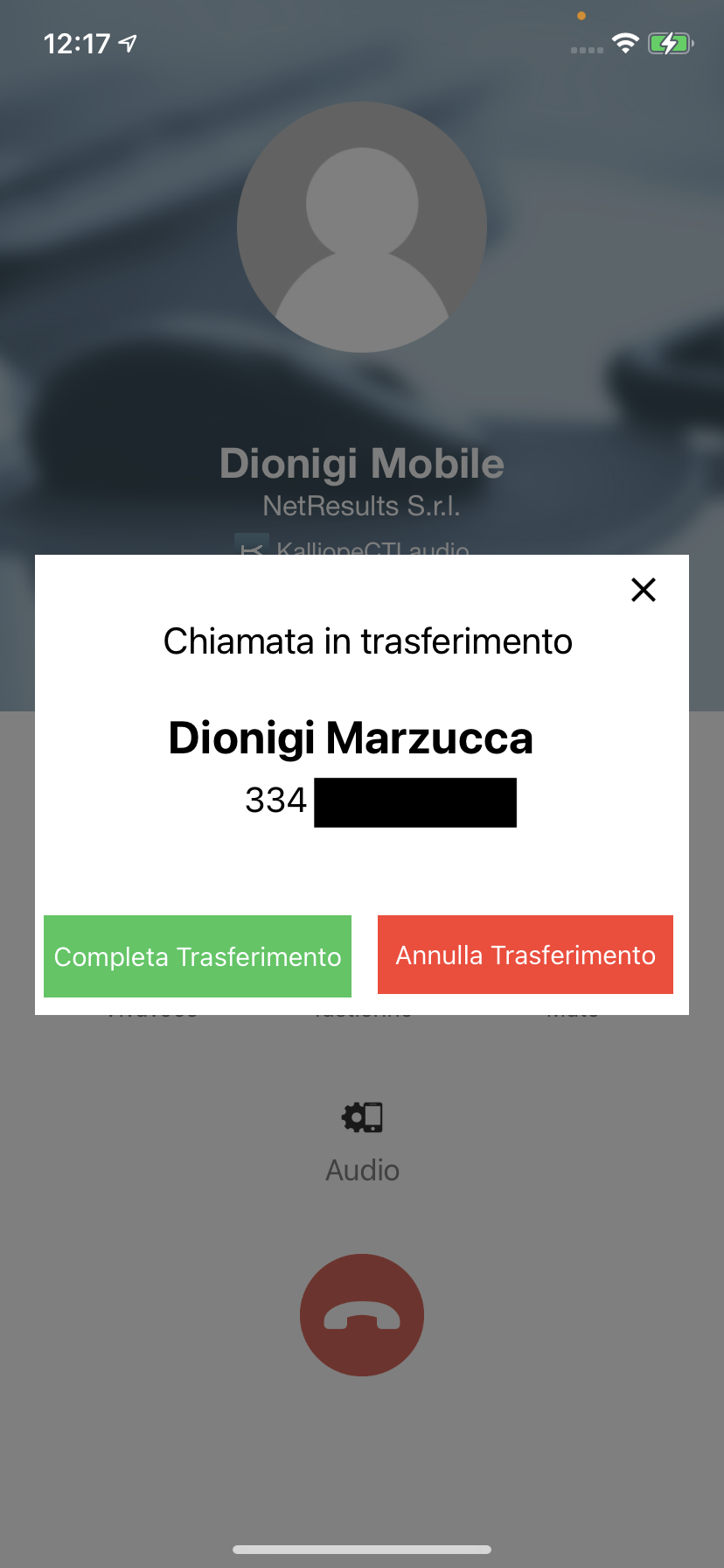
Numeric Keypad
In this case the number of the contact can be entered directly from the keypad and the call can be transferred. After entering the number and pressing the green button you will get to the Contact Information Screen ), but in this case you will see only the number and not the name of the contact ( picture below )
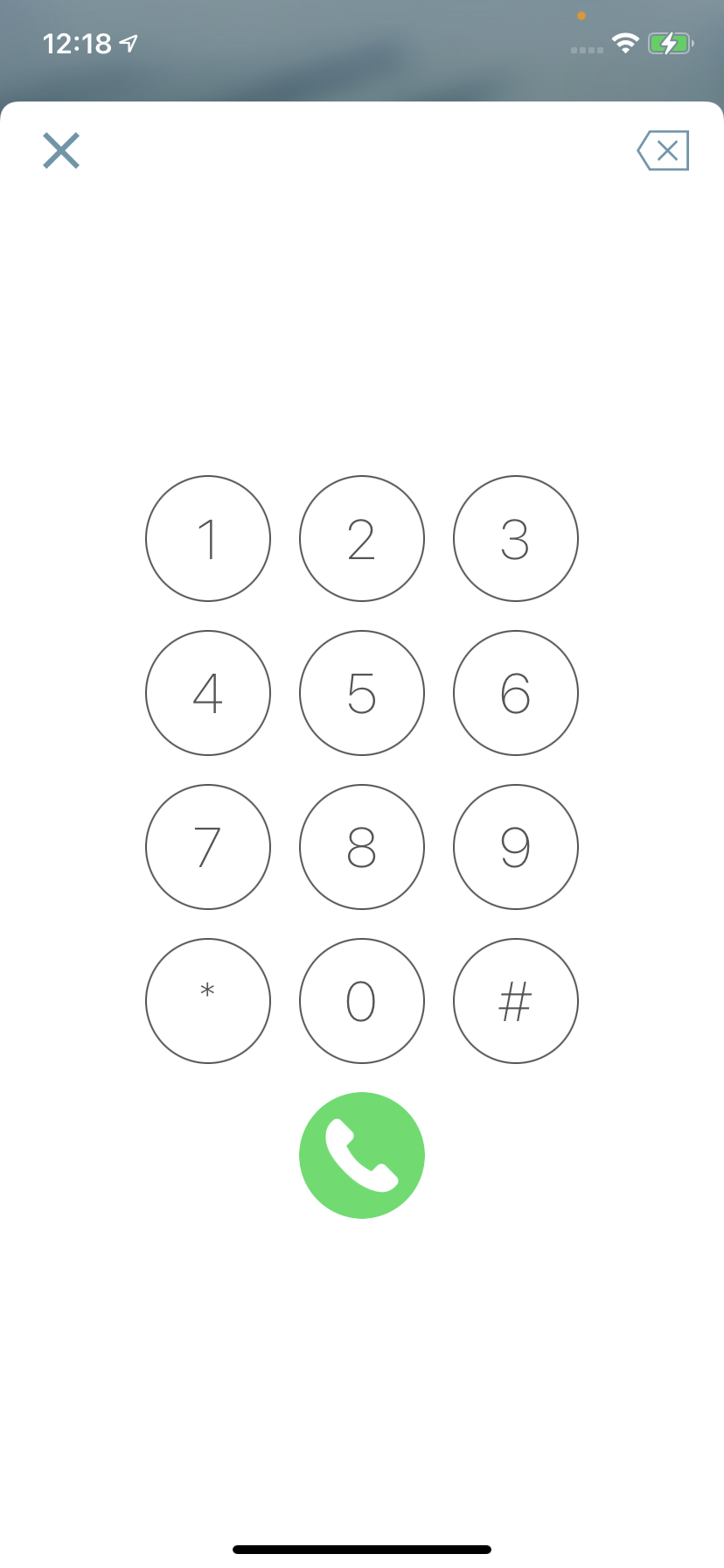
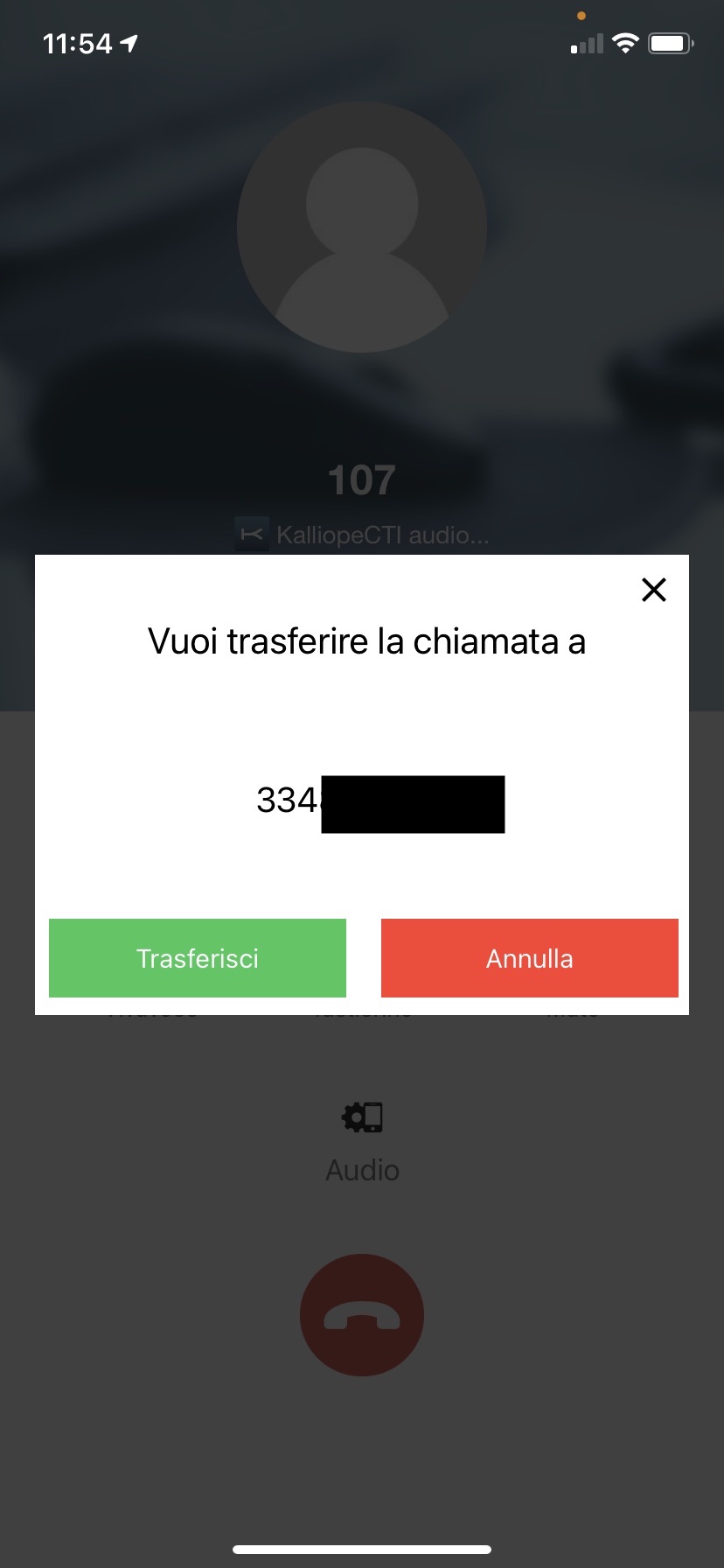
Outgoing calls in CTI mode
Regarding outgoing calls in CTI mode, KalliopeCTI mobile app offers three different types of call setups.

Call-back
The Call-back service allows you to call from your mobile device using the KalliopePBX’s lines. By pressing this key, the KalliopePBX makes a call to the mobile number associated with the extension, answering and pressing key 1 (as requested by the guide voice) you are actually put in communication with the desired number. The caller will see a call coming from the geographical number assigned to the Kalliope PBX. Questa is the type of outgoing call setup used by default in CTI mode.

Click-to-call
Click-to-call mode: the stationary device associated with the extension receives a call from KalliopePBX whose caller is c2c: called number. Answering this call will initiate a new call to the desired number.

Using directly the SIM of the device
In this mode, the call is made directly from the SIM of the device on which the KalliopeCTI Mobile app is installed. A simple direct GSM call is then established and then the caller will see the user’s mobile number as the calling number.

Outgoing calls in Softphone mode
Regarding outgoing calls in Softphone mode, KalliopeCTI mobile app offers the following three types of call setups.

Chiamata SIP
SIP call: outgoing calls leave directly from the app via SIP protocol using the data network provided by the softphone. It is fully equivalent to a call originating from the KalliopePBX extension associated with the user. This is the type of outbound call setup used by default in Softphone mode.

Call-back
The Callback call service allows you to call from your mobile device using the KalliopePBX’s lines. By pressing this key, the KalliopePBX makes a call to the mobile number associated with the extension, answering and pressing key 1 (as prompted by the guide voice) you are actually put in communication with the desired number. The caller will see a call coming from the geographical number assigned to the Kalliope PBX.

Using directly the SIM of the device
In this mode, the call is made directly from the SIM of the device on which the KalliopeCTI Mobile app is installed. A simple direct GSM call is then established and then the caller will see the user’s mobile number as the calling number.
Dialing a number directly from the keypad will establish a call via SIP. Once the call is established, the “Active call” screen will automatically be displayed.

Keypad
Aside from searching the phonebook, you can also dial the number you wish to call with Kalliope directly on the KalliopeCTI mobile app keypad. While dialing, you will be shown autocomplete¹ suggestions.
In call-back mode: Tapping the call button lets you choose which mode to use among the ones listed above.
In softphone mode: Tapping the call button will directly establish a SIP call.
Note
The KalliopeCTI keypad does not automatically add the outbound prefix. You will need to dial the number as you would on a landline phone.
¹ Feature only available on Android.
Services
Services related to the KalliopeCTI mobile app can be accessed on iOS via the System Menu.
Three services are currently available: presence (seen above), unconditional forward, and fork to mobile.

Unconditional Forwarding
Unconditional forwarding allows you to configure an extension number to which all incoming calls are automatically forwarded (this function is valid only for calls directed to the extension and not for those coming from groups or queues).
This service is useful when you are not available but wish to redirect inbound calls so they can be dealt with.
To enable the unconditional forward service, simply tap the arrow icon, input the extension number to which you wish to forward calls, and save.
To disable the service, simply click on the same switch again.
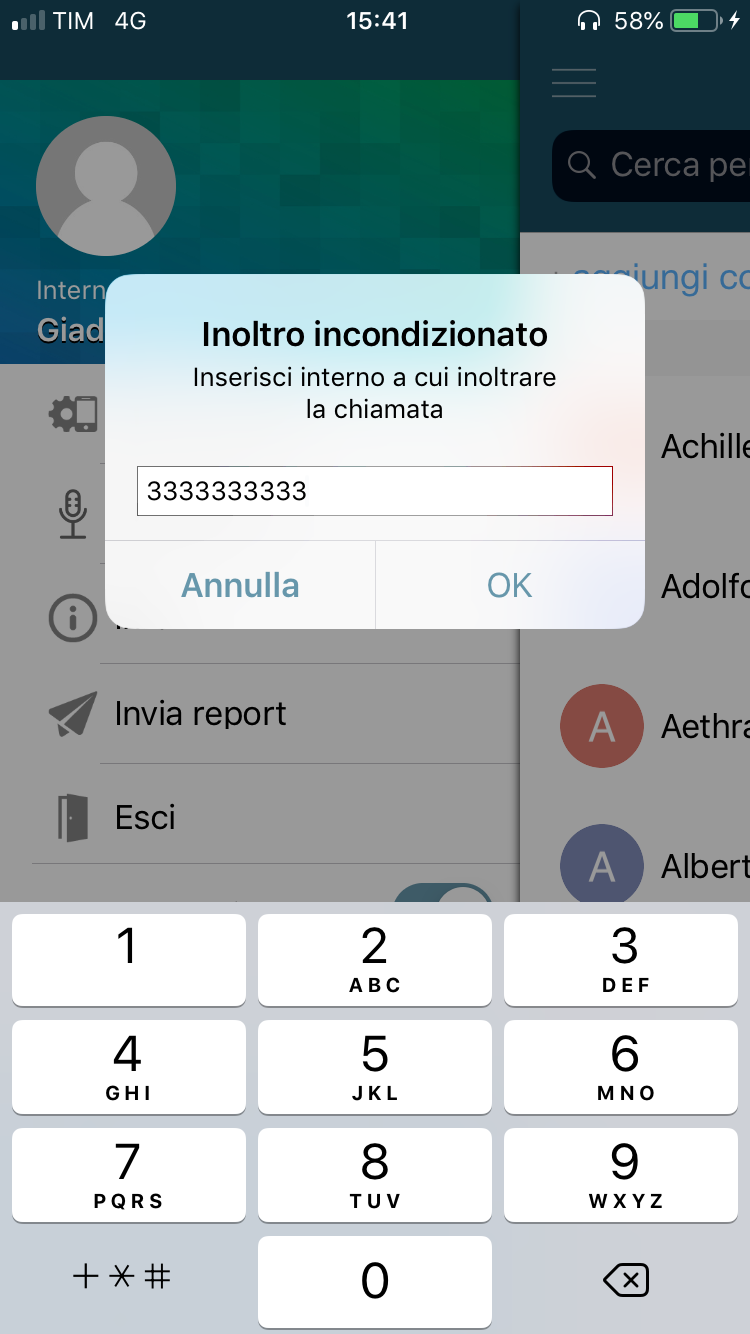
Fork to mobile
Fork to mobile consists in distributing the direct call to an extension also to the associated mobile number. This function can be set on Kalliope only by the administrator and not by the user.
Answering the call on the mobile phone will cause the extension to stop ringing, and vice versa.
To activate the service, simply click on the appropriate switch on the System Menu. Again, the status of the switch denotes the activation status of the service.
Privacy Policy
Secure connection
In order to offer its services (e.g. telephony, real-time notifications, chat), KalliopeCTI must be able to communicate with KalliopePBX. This communication is made through an encrypted connection, guaranteeing the security of transmitted personal data and messages.
Contacts
You can give KalliopeCTI permission to access the contacts on your device. The saved contact data will only be used within the app and will never be sent to KalliopePBX or exchanged with other users, except for the information required to make calls via the PBX.
Files
KalliopeCTI will access the phone’s memory in order to send diagnostic data to the KalliopePBX developers via email. This data will only be sent when the user selects the “Send report” item in the KalliopeCTI menu.